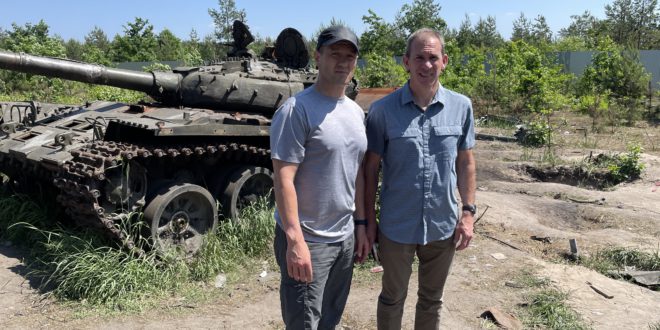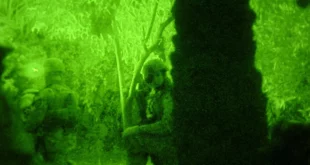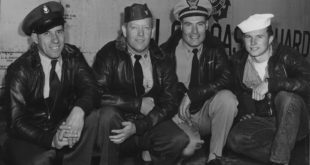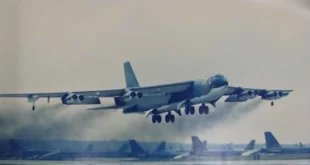By Liam Collins and John Spencer
Editor’s note: Authors Liam Collins and John Spencer are U.S. Army veterans and urban warfare experts. Collins is a retired Special Forces colonel, and won the Best Ranger competition in 2007. Spencer is a former Ranger Instructor who served 25 years as an Infantryman (you likely have seen him on television discussing urban combat). They recently traveled to Ukraine to research the defense of Kyiv. Here is some of what they saw and learned. ~SKK
Western Ukraine looks like the Midwest, where both of us grew up – a flat, never-ending expanse of farmland punctuated by faceless Soviet-era apartment blocks. This is Europe’s breadbasket and it’s easy to see why. The country looks like a mirror image of its blue-and-yellow flag.
Or at least it does from the drive from Lviv to Kyiv, which takes about six hours by car. The ride would be shorter but as we approach the outskirts of the capital we notice something missing: road signs. The signs were all spraypainted over or missing. We had heard about Ukrainians covering the signs to make navigation more difficult for the invading Russians. But seeing it in person was one of the first signs that something was amiss.
The other noticeable sign of fighting was the gas stations. Our driver, a young Ukrainian from Lviv named Fedir said he needed gas but was not sure which gas stations had fuel. The Russian missile attacks had taken out most of Ukraine’s fuel infrastructure. Most gas stations we passed were either closed with prices of “0.00” listed on their boards or required hours-long waits in line.
Fedir called our host in Kyiv, Kristina, who directed us to an open and fast moving, albeit costly, gas station.
As we approached Kyiv, even before its skyline of green onion domes came into focus, the amount of visible damage increased – burned-out cars, the rubble of buildings that once bustled with activity, the corpses of Russian vehicles left abandoned on the side of the road. Some cleanup had obviously occurred. But holes in the road and burn marks told a clear story that fighting had recently happened there. Ukraine is the second largest country in Europe. Russia seems intent on making it smaller.
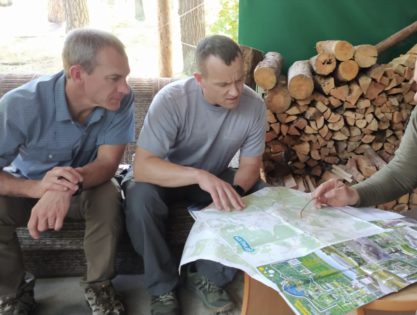
When Russia invaded Ukraine on February 24, our first instinct was that we needed to visit as soon as logistically possible. Both of us had fought in America’s post-9/11 wars. At West Point we had brought cadets to study recent wars in Sri Lanka, Colombia, Georgia, India, and Bosnia. Ukraine, we knew, would be a pivotal war – because of its marriage of modern technologies with urban and conventional warfare – would be studied by historians for centuries to come. It was only natural to want to study this war while it was happening.
After the first phase of the war, when Ukraine’s successfully defended its capital, the war migrated east, opening up travel to Kyiv for outsiders. Western embassies reopened and life took on a new normal. Bars and cafes hummed with activity. The prewar traffic jams returned.
So in early June, we both flew to Warsaw. After a four-hour drive, we arrived at the Ukrainian border. There were only a handful of vehicles crossing and no pedestrian traffic. With full commitment we grabbed our backpacks and started walking toward the crossing vehicle lanes. After some wandering around, hand gestures to border officers who clearly did not speak English, we found the pedestrian crossing.
The officer we were eventually handed off to asked, “Where you go?” “Ukraine,” we replied. He laughed and said, “More.”
“Lviv,” we responded.
He laughed again, stared at our passports, and loudly stamped each. But instead of handing our passports back, he walked them, with us following them like dogs tracking their favorite toy, to the nearest vehicle attempting to cross the border. To the surprise of both us and the driver, the guard ushered us into the vehicle. Taken aback, the driver and her passenger rearranged the groceries in the back of their vehicle to make room for our bags and us. Like the boatlift at Dunkirk or the presence of ordinary taxis at the battle of the Marne, the war here leaned on everyday Ukrainians (and Poles) to fill in the war’s logistical gaps and become makeshift Uber drivers.
The long drive across Europe’s Breadbasket
Just across the border we met Fedir. Fresh out of college, Fedir was a church school manager in Lviv who moonlighted as a driver to supplement his income.
The long drive across Europe’s Breadbasket gave us a chance to get to know Fedir. He was very happy to share his story as well as genuinely interested in why we were there. We had a lot of questions. How did he feel about the war? What had he been doing from the beginning? Was he preparing to go fight?
He told us that he was of course ready to fight but had not yet been called to do so. While martial law meant that no male between the ages of 18 and 60 could leave the country, the government had not yet called up Fedir. He said they had started with recent veterans, then any veterans, and then not-yet-drafted men with no military experience.
Originally, we had planned to travel to Kyiv that first night, but with curfew starting at 11:00 p.m., we did not think we could make it in time. So we crashed in Lviv, a city pockmarked with beautiful Catholic basilicas and plazas swarming with pedestrians.
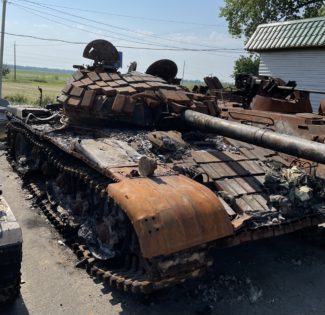
It was clear from checkpoints and blocking positions along the highway that the nation was at war, but Lviv itself, in Ukraine’s west, was far from the active combat zones.
Other than the soldiers on rest and relaxation; statues, monuments, and windows protected with sandbags; and an occasional missile siren; it looked fairly normal. But what is normal in a nation at war? Were the people we saw from parts of Ukraine that were now occupied by Russia? What is normal when you know that a missile could strike the city at any time?
We met an American friend for dinner that night. He was serving with the International Legion of Territorial Defense of Ukraine. Shortly after the war started, Ukraine had established “The Legion,” as many call it, as a way to bolster its armed forces with foreigners. But at that time, they were not just taking any foreigners; they were fairly selective, allowing only veterans with combat experience to join.
“Follow me,” our friend said hurriedly, after meeting us in the city square. “I want to get to the restaurant early. The air sirens for a missile attack have been going off every evening and if they do, the restaurant has to close.”
While hastily walking to the restaurant, he pointed out that many of the soldiers we saw in uniform with their families were coming from the frontlines. Ukraine had been at war for over four months. As old soldiers, we could appreciate that fighters cannot be left on the front line indefinitely –they must get mental and physical breaks and, if possible, see their families.
Curfews were in place to keep civilians safe from potential bombings and to help keep possible enemy forces, a real concern, from using the cover of darkness to move around or infiltrate cities. The curfew was lifted at 5 am each morning. After a morning run, we departed promptly at 6 am.
Understanding the Battle of Kyiv
After nearly two days of nonstop travel, we finally reached our first battle site – a group of burned-out Russian tanks along a road leading to Bucha near the village of Dmytrivka. When we pulled up, we saw a group of people next to a car, one in military clothes and two females in civilian clothes. One of the civilians was our host, Kristina. We shook hands and made quick introductions. Then our military guide immediately launched into a story of what had happened at the site. They were clearly there to give us what we had come for. We were there to understand what had happened during the battle of Kyiv. To do that, we needed to not only walk the ground where things had happened, using our own eyes to see the key sites in the overall battle, but also to hear firsthand stories of the fighting. This place was one of the first engagements. A Russian tank column trying to find a way into Kyiv met a father and son team with a rocket propelled grenade launcher hidden in the woods next to the road. We asked for the man to clarify, “So these were civilians, not military?” He nodded. “Volunteers.” We would hear that term many more times over the coming days.
Our next stop was Bucha. Bucha became a household name in the international press this past spring because of the reported atrocities that Russian soldiers had committed there. These reports claimed that the Russians had tied the hands of women, elderly men, and shot them in the back of the head execution style or shot people just riding bicycles. They buried some of their victims in unmarked mass graves and left many lying in the streets where they were shot. It felt like sacred ground just driving into the village. We passed through streets lined with the ruins of houses festooned with signs that read, “We love Bucha.” We drove through the heart of the city and stopped at a city forest camp that looked like a mix between a Boy Scout retreat and military field base.
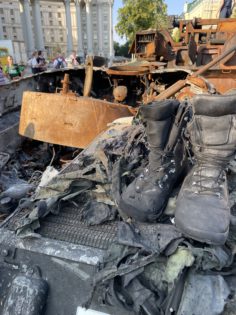
Our welcoming party was a group of men dressed in a variety of olive green, camouflage, and civilian military style outfits. Some wore boots, others tennis shoes. We were introduced to the group’s leader, a beefy man with a very stoic demeanor and hands the size of ham hocks that we just called “Colonel.” He introduced each of the men standing with him and explained they were part of the Bucha Community Defense Force. These volunteers were not part of the Ukrainian Army. They were a community resource paid for by the local community.
After a quick lunch in their barracks-style cafeteria, we moved to a map where the colonel explained what had happened in the opening days of the war. He, like most of the volunteers surrounding him at the map, had been civilians on the day Russia invaded. But in the first day or two of the war, he and tens of thousands of others showed up at recruitment stations around Kyiv where they were issued an AK-47 rifle and two magazines. Many of them were combat veterans who had fought against Russian-led separatists in 2014 and 2015 or in the Donbas over the past seven years. But some had no military experience at all.
A shy sniper
The veterans served as the backbone to a volunteer fighting force that self-organized and moved to fight any Russians they could find. They led other volunteers, including a fighter we met who could not have been older than 19, who they said served as a sniper in the opening days. The young man was shy, timid, looked down when they spoke about him. But according to the group, he had many confirmed kills. It was not until after the Ukrainians had successfully defended Kyiv that the volunteers became more formally organized into the defense structure.
After our map briefing, the Colonel showed us some of the volunteer training. Lacking extra ammunition or a firing range, they were doing dry fire rifle drills. He also handed us many of their rifles and machine guns with pride. The weapons were Russian. The paradox of the Russian presence in Ukraine is that it often armed the Ukrainians—it was clear that battlefield recovery can be a useful method of supply in conventional conflicts just as it is in guerilla war. After every successful ambush or engagement, the Ukrainians were very effective at collecting any useable weapons or supplies.
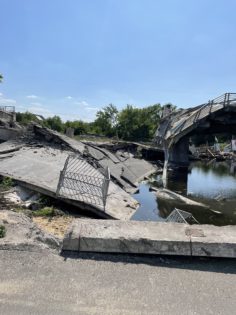
It became apparent that these volunteers were not just telling us what they had done to defend Bucha, but also that they were ready and expecting to defend it again, even more aggressively than before. The following day, our hosts showed us a low-lying area where Russian tanks had gotten bogged down in the mud earlier in the war. The Ukrainians had recovered many of these and were now using them, with the exception of one tank that was still stuck in the mud.
After our visit with the Colonel and his team, we said our goodbyes and drove our car to Vokzalana Street, which connected Bucha with Irpin. We stopped at a spot made famous by a photo that had circulated on social media around the world. The photo showed a street packed full of burning Russian vehicles, basically bumper to bumper, with Ukrainian civilians walking amongst the ruins. A Ukrainian military vehicle sat at the very top of the road with the national blue-and-yellow flag flying, symbolic of the resistance to the Russian invasion.
Our military escort explained how that Ukrainian win was achieved. In the opening days of the war, the Ukrainian military blew up dozens of bridges around Kyiv. The Vokzalana Street bridge between Bucha and Irpin was one of the few left standing. So it was the perfect spot for an ambush. Ukrainian volunteers manned positions on the far side of the bridge, while regular army soldiers took up positions next to a shopping center called the Giraffe Mall. On the eighth day of the war, a massive Russian convoy of armored vehicles, fuel trucks, and more attempted to simply drive up the road and over the bridge. Regular army soldiers engaged the lead vehicle and volunteers engaged the trail vehicle with a rocket-propelled grenade. The vehicles in the tightly packed convoy were now trapped with nowhere to go. And so Ukrainian artillery decimated the Russian convoy that had been traveling in more of a parade formation than a combat formation. Imagine the Macy’s Day parade in New York, yet with sharpshooters armed with RPGs along Broadway tasked to shoot down floats of Elmo and Bart Simpson.
Outsiders peering into our old profession
On the next day, we met with officers from the 72nd Mechanized Brigade at a military headquarters building inside Kyiv. The building resembled the thick concrete fortress architecture of typical military sites and had the familiar busy bustle of officers and soldiers moving between meetings to issue combat orders. We felt like outsiders peering into our old profession.
The 72nd was the Ukrainian Army force assigned to defend the city. The uniformed officers were not as engaging as the volunteers we had met the previous day. The meeting was more of a stiff, military-style gathering of prepared table setting with name plackards and blank notebooks waiting to be filled in with important information. The Ukrainian officers sat on one side of the table with an interpreter and us on the other. We knew that the quality of our questions would determine their willingness to share. It didn’t take long for the officers to understand that we had studied much of the battle beforehand and we were combat veterans. Soon, they started to ease in their demeanor.
For questions such as “when did you occupy your positions?” we could tell from their eyes they had a vested interest in answering. That question exposed the fact that they were not allowed to be in defensive positions with their weapons and equipment prior to the Russians crossing the border. But it was a political decision that, as soldiers, we knew was out of their hands. So they did not have much to say on that particular subject. Norms of not criticizing one’s civilian overseers run deep on both sides of the Atlantic.
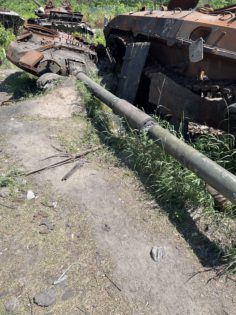
However, when we asked about specific actions at the tactical level, they were more forthcoming. One of the officers, a major, had been part of the initial response to the Russian seizure of the Antonov Airport on the opening day. The more questions we asked, the more we realized that he had seen a significant amount of combat in a very short period of time. Many of his friends, some of the soldiers involved in the defense of Kyiv, were now dead or deployed to fight in other parts of Ukraine and may soon be dead. It gave a reminder of why we were in Ukraine. The firsthand accounts of defending Kyiv were disappearing and needed to be recorded. We ended our meeting with stiff handshakes and a warrior respect that said more than words – good luck.
Glimpsing the airfield
While we discussed the operations around Hostomel and the Antonov Airport with the 72nd Mechanized Brigade, we still wanted to visit these places ourselves. Kristina and our military guide had other meetings to go to so we told Kristina that we would just go by ourselves. She said “OK, but the airport is closed for reconstruction. I already tried to get you in, they said it wasn’t possible.”
We still wanted to try, so with Fedir as both our driver and translator, we headed for the airport. When we got to Hostomel, we drove around the city area, only getting a glimpse of the airfield from behind a chain-linked fence. Russia had seized the airfield in the opening hours of the war with its elite paratroopers in the hopes of establishing an airbridge to bring in troops and supplies to rapidly seize Kyiv. But a Ukrainian counterattack, that included the major we had spoken with, had thwarted Russia’s plans and made the airport unusable. Unable to see much in Hostomel, we decided there was still enough daylight to visit Moschun.
Moschun is a tiny village northeast of Kyiv that saw heavy fighting. After the Russians failed to enter Kyiv because of blown bridges, flooded rivers, and complex ambushes, they found a potential way in through Moschun. They successfully emplaced a pontoon bridge over the Irpin River and just needed to drive through Moschun to enter Kyiv’s outskirts. But volunteers and a single Ukrainian company from the 72nd were able to halt the Russian advance using the thick woods and constraining roads. The battle of Moschun was a nightmare for the Russians who likely were relieved to successfully bridge the river obstacle only to face a single access road through urban terrain lined with Ukrainian fighters hidden in thick woods and providing a perfect ambush situation.
As we approached Moschun, the terrain changed. Leaving the concrete jungle of Kyiv and Hostomel, we drove through a thickly wooded area before entering the town. Nearly every building in Moschun had been destroyed or significantly damaged. We attempted to drive to the pontoon bridge site. But the newly paved road had turned to gravel in the town and as we approached the outskirts, the road had narrowed to a single-lane dirt path. We saw a few bike tracks in the road, but no signs that vehicles had recently trafficked the road. As combat veterans and researchers who study contemporary war, we knew that this area may have been mined. Thus, despite wanting to see the crossing point for ourselves, discretion being the better part of valor, we felt it best to return to our hotel for the evening.
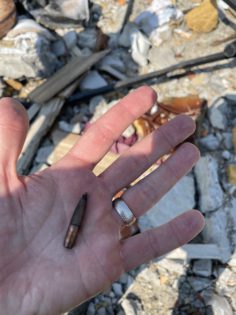
Maps and chalkboards
The next day our hosts took us to Brovary in the east of Kyiv. Our first stop was a local government building that had been converted into a military headquarters. It was a very familiar scene to the both of us. Maps splayed across the walls with lines drawing boundaries and icons symbolizing units; soldiers on chairs next to blinkering computer screens and radios; messy chalkboards conveying information about missions or the status of units. A colonel and a general we met brought us to a large map and briefed us on the Russian invasion in eastern Kyiv.
It was not until the briefing was almost complete that we started to question, “Who the heck are these guys?” We were brought in so fast that we had not had time to ask their unit. Their uniforms and other insignia bore no formal badges. We had initially assumed they were from the 72nd Mechanized Brigade. What we discovered was that after successfully defending the capital, most of the 72nd had moved to the east of the country and left the current defense of Kyiv to volunteers. They were not part of the army, but more akin to a county defense force, if such a thing existed in the United States.
The general served as our tour guide. Our first stop was along the M01/E95 highway around the Skybyn, the last town along Kyiv’s northeast corridor. We had both seen haunting videos of a massive anti-armor ambush that had occurred here. In a weird attempt to penetrate Kyiv, the Russians had come down the highway in seemingly a parade column of tanks and armored infantry carriers, only to run into a Ukrainian ambush. At the site we meet Ukrainian volunteers that had been a part of that ambush with the 72nd mechanized brigade.
Once again, this was a story of how Ukrainian volunteers, that were civilians only days earlier took up the defense of their nation in any way they could. This time they supported a pre-designated blocking position at another bridge left open into Kyiv. Similar to the previous ambush, this one included a mix of conventional Army and volunteer soldiers—supported by Special Operations Forces—that had engaged the Russian convoy.
One thing different at this site from any other was the flies. They were all over us. They were on the attack. We spent the entire time swatting them away as different people discussed their role in the ambush. We knew from both the flies and the smell that there was something around, most likely the remains of dead humans. It was an eerie reminder of how fresh the conflict was.
“Beware of mines”
We made many stops that day and nearly all involved heroic stories of people who only a few months ago had been everyday civilians going about their daily lives. These volunteers served in both combat and non-combat roles and sometimes they provided critical intelligence. We stopped at one particular location where it was clear that a number of Russian vehicles had been burned to the ground. The area was surrounded by a wire fence with signs indicating the area was mined. We were shocked to see that our guides wanted us to enter a mined area. But it was soon clear that the area had not, in fact, been mined. The signs were only there to indicate the unexploded ordnance present.
The general described how the Russians had established a resupply and refueling point east of Kyiv. A Ukrainian babushka notified appropriate authorities of the Russian position. Hours later, the Ukrainian military stuck the position, scoring a direct hit and destroying the dozen or so fuel and ammunition trucks at the site. The fireworks show from the cookoff of the rounds lasted 90 minutes. The fire lasted more than a day. The strike killed all but a single Russian soldier who was lucky enough to be relieving himself at the time. Miraculously, the women and her house escaped unscathed. “Even God is on Ukraine’s side,” the general noted.
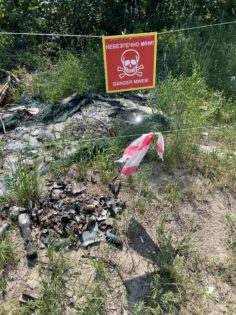
On our last day in Ukraine, and as we loaded our backpacks into Fedir’s car, Kristina pulled up with a different military guy with her. We were not introduced, only motioned by Kristina to follow her. The previous day we had mentioned that we wanted to learn more about Ukraine’s intentional flooding of the rivers northwest of Kyiv, so we could only assume this is where we were going.
We knew that the Ukrainians had opened a dam to flood the Irpin River. But we had been surprised to learn that the flooding was much more complex than simply opening a single dam. It was a well-planned and well-orchestrated operation that involved flooding the Irpin, Zdyzh, and Teteriv Rivers.
We made a quick stop at a gas station to grab some water and snacks. At this time, we were finally introduced to our guide who was a lieutenant colonel in the Army. We tried to buy water and snacks for our hosts, but as had happened to us many times during our trip, they refused. Despite being a nation at war with a suffering economy, they remain a proud people and refused even this simply gesture that we would offer any host in peace or war.
We then stopped at a checkpoint manned by volunteer soldiers guarding a bridge over the Irpin River. After a brief conversation between our guide and the guards, we continued on and stopped a few hundred meters later. The dam on the Irpin River had been destroyed, and the area remained flooded. We could see from the terrain and by Google Maps, that what should have been low lying fields was still the completely flooded fields outside the village of Demydiv. We judged the water to be 15-20 feet in depth based on the trees and telephone phones in the flood zone.
As our guide was describing the flooding operation, the soldier from the checkpoint approached and started yelling. Apparently, he did not like the fact that we had stopped to take pictures and discuss the operation. Not to be deterred, our guide proceeded to yell back.
We hoped it would not escalate, but things were not trending in the right direction as the two proceeded to argue for the next ten minutes. It was not clear to us if the argument had been resolved but our guide told us to get in our vehicles and we drove away. We did not feel that we were in the clear until we passed the checkpoint on the north side of the bridge without being detained.
Flooding the waterways
Our stops at the bridges over the Zdyzh and Teteriv Rivers were much less eventful, but together they provided a good understanding of the flooding operation. Ukrainian engineers flooded the waterways enough to make the low-lying areas impassible but not so much that the flooding would cause significant damage to the rural towns. This forced the Russians onto the very limited number of roads and made them easier targets for Ukrainian war planes, artillery, drones, and ambushes.
Our final stop that morning was near a large traffic circle just 50 kilometers south of Chernobyl. Above the traffic circle was a large billboard advertising tours of the facility. Our driver clearly did not like being in the area for two reasons. First, he was deathly afraid of the nuclear radiation and constantly talked about how the Russians had dug in the contaminated “red zone”—the highly contaminated exclusion zone—during the initial invasion. Second, he seemed genuinely fearful that the Belarusians would somehow swoop into Ukraine and grab him, despite the fact we were 70 kilometers from the border.
The lesson is clear
With the long drive to Warsaw, our biggest fear was not the Belarusian boogeyman, radioactive waste, or Russian rockets, it was fuel. We needed gas prior to the border, and we could never be certain which stations would have fuel and if they did, how long the lines might be. It appeared that fewer than one in five gas stations had fuel and those that did often had long lines, sometimes hours long. We did not want to run out of fuel or have to wait hours for fuel. Fortunately, we found a station with shorter lines and filled up the tank after only about a half-hour wait.
After half-a-day of driving, we finally arrived at the Polish border. It was clear that more people were entering Ukraine than leaving it—a good sign that some are able to return home despite the country still fighting a vicious war. We even had time to help some Red Cross workers set up a tent to receive refugees fleeing the fighting in the east of the country.
What struck us, as we waited for our driver to pick us up at the border, was the culture of volunteerism that permeated this war. Even though they know there was a long road ahead, morale seemed high, at least for the moment. War upends daily life. Drivers, snipers, logisticians – everyone pitched in to do their part for the war.
The lesson of Ukraine is clear: Wars are no longer fought solely between regular armies.
Liam Collins is the executive director of the Madison Policy Forum, a member with the Council on Foreign Relations and a fellow with New America. He also served as a defense advisor to Ukraine from 2016-2018. He is a retired U.S. Army Special Forces colonel with deployments to Iraq, Afghanistan, Bosnia, the Horn of Africa, and South America. He is co-author of the forthcoming book, Understanding Urban Warfare. You can find him on Twitter, @LiamSCollins.
John Spencer is the chair of urban warfare studies at the Madison Policy Forum. He served 25 years as a U.S. Army infantryman, which included two combat tours in Iraq. Together, he and Collins traveled to Ukraine in June 2022 to research the defense of Kyiv. He is the author of the book Connected Soldiers: Life, Leadership, and Social Connection in Modern War and co-author of the forthcoming book, Understanding Urban Warfare. You can find him on Twitter, @SpencerGuard.
 Soldier of Fortune Magazine The Journal of Professional Adventurers
Soldier of Fortune Magazine The Journal of Professional Adventurers


